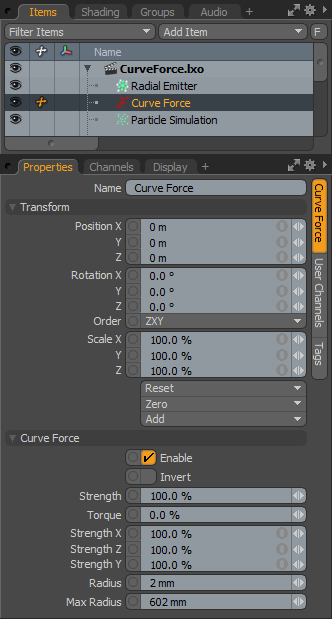Curve Force
The curve force allows you to use a drawn curve to determine the directional flow of dynamic items, flowing from the curve's base, the first point, toward its end point. The curve force is useful in cases such as getting particles to flow through a bent hollow tube or along a meandering stream.
The curve force requires a curve to apply the force with, so you need to draw a curve of some type, either a Hermite Adding Curves or a Bezier curve. It is a good practice to keep curves isolated withing their own mesh layer. With the curve created, you can add a curve force item to a simulation by selecting Forces > Curve in the Layout interface's toolbox. Alternatively, in the Items list, click Add Item, and under Forces, double-click Curve Force. Once created, it is necessary to connect the items manually within the Schematic viewport. The Mesh Item containing the curves needs to be connected to the mesh input of the curve force item.

Remove force items the same way as any other item: simply select the item and press Delete on the keyboard.
When selected, the following attributes appear in the Properties viewport.

|
Option |
Description |
|---|---|
|
Name |
Displays the current force item name. To change it, click on the field and type in the new name. |
|
Transform |
|
|
Position X/Y/Z |
The curve force item affects dynamic items based on the position of an external curve item, therefore these values don't influence the force's effect. |
|
Rotation X/Y/Z |
The curve force item affects dynamic items based on the position of an external curve item, therefore these values are not applicable to it. |
|
Scale X/Y/Z |
The curve force item affects dynamic itemsbased on the position of an external curve item, therefore these values are not applicable to it. |
|
Curve Force |
|
|
Enable |
Toggles the force item on or off. When enabled, the force item is considered during a dynamics simulation; when disabled, the force item is ignored. However, disabled forces are persistent across Modo sessions, being saved with the scene, and retain their present settings. |
|
Invert |
Reverses the direction of the curve force where the force flows from the end toward the base. |
|
Strength |
Determines how much influence the curve force has on the dynamic items. The higher the value, the greater the influence of the curve force. |
|
Torque |
Acts as a multiplier on rotational movements of dynamic items. The higher the value, the greater the influence of the curve force. |
|
Strength X/Y/Z |
Acts as a multiplier over individual directional vectors as dynamic items move along the curve. |
|
Radius |
Determines the area or volume around the curve where dynamic items try to remain constrained, unless affected by other stronger forces. |
|
Max Radius |
Determines the maximum area around the curve where the force tries to attract dynamic items. Anything outside this area is ignored. |
